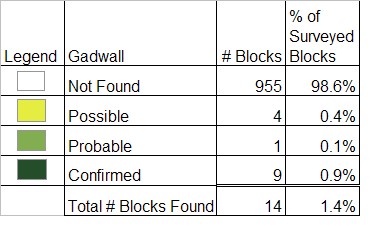Find a Bird - BBA1
Breeding Bird Atlas 1 Species Accounts
Gadwall
Anas strepera
Egg Dates
late April to late May
Number of Broods
one; may re-lay if first attempt fails.

The Gadwall, a common resident of the prairie pothole region of North America, is a relatively new nesting species in Massachusetts. A small breeding colony was established at Great Meadows National Wildlife Refuge in Concord by introducing flightless young from the Delta Wildlife Research Station in Manitoba, Canada, in 1965. In 1971, the Felix Neck Wildlife Sanctuary imported forty-two Gadwall ducklings from the same source in an effort to establish them on Martha’s Vineyard. In 1977, Gadwalls nested in a marsh at Felix Neck and also on nearby Chappaquiddick Island. Each year since then, there have been two to four pairs nesting on Martha’s Vineyard.
Possibly due to these introductions, but more likely as a result of natural range expansion, the Gadwall became established in coastal northern Essex County at Parker River National Wildlife Refuge and vicinity. This population has increased gradually. A small group is also present at Monomoy National Wildlife Refuge. The overall number of Gadwalls throughout their normal nesting and wintering ranges has risen considerably, with some tendency toward eastward expansion.
Breeding birds arrive as soon as the ice melts on ponds and marshes, often as early as late February in mild seasons; migrants are occasionally noted away from nesting areas. Gadwalls may delay breeding, possibly due to the retarded growth of vegetation in some cooler areas.
The drake Gadwall is relatively quiet but does produce sounds similar to, but somewhat higher pitched than, those of the Mallard drake. During courtship he makes a burping sound and uses several ritualized displays. The hen utters the typical quack calls. Gadwalls, like most dabbling ducks, prefer to nest on dry, open upland near water but will occasionally travel some distance from it. Small islands are favorite sites. A snug, grass nest is built and lined with down.
Gadwalls lay five to fourteen creamy white eggs, with ten being the normal clutch. The female incubates the eggs for 24 to 27 days, then leads the downy young to water within 24 hours after hatching. On Martha’s Vineyard, most broods appear during the first week of June (Ben David). Brood dates at Parker River and Concord range from June 12 to August 16. On Monomoy a female with four young was observed on July 5 (Humphrey). Gadwalls nesting on ponds with sparse cover suffer high brood mortality. The young mature rapidly and are capable of flight as early as 50 days after hatching.
Small flocks begin forming in late summer, and, in some areas, especially on Monomoy and Plum Island, numbers reach more than 100 birds in October. Although some Gadwalls winter as far south as Central America, there is evidence that our population moves only short distances as a result of freeze up. Appreciable numbers winter on the ponds in coastal Rhode Island, where the species is very scarce as a breeder. The individuals on Martha’s Vineyard show a preference for tidal marshes. This adaptability will no doubt be an advantageous survival factor during severe winters when freshwater habitat is frozen. Gadwalls are sometimes found during the winter in coastal bays in the company of black ducks and other waterfowl and occasionally inland at duck feeding areas.
Map Legend and Data Summary
Atlas 1 data collected from 1975-1979


Note: very uncommon and local; mainly at coastal national wildlife refuges
Augustus Ben David II



